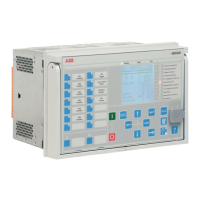is typically related to satisfying these two performance criteria. Depending on the
requirements set to the electricity distribution process, one of the criteria may get
more attention than the other. However, in some industrial electricity distribution
networks, the main (productization) process is so dependent on reliable electricity
supply that both criteria are addressed equally.
The examples presented focus on the relay’s protection role in the fail-safe circuitry
using traditional hardwiring. If communication between the relays, or to an upper
level system, is a part of the fail-safe functionality, it must be also be a part of the
circuitry.
3.2.3.1 Motor feeder
The target is to prevent the motor from running uncontrollably and to secure the
emergency stop circuit functionality.
<U
TC1
-Q0
AUX. POWER
-A1
Control +
Control -
IRF
ES
TO
-F1
Figure 13: Motor feeder fail-safe trip circuit principle, example 1
A1 Protection relay
ES Emergency stop
Q0 Circuit breaker (CB)
TO Protection relay trip output
IRF Internal relay fault indication
<U CB undervoltage trip coil
TC1 CB trip coil 1
DCS Distributed process control system
F1 Miniature circuit breaker
In example 1, the fail-safe approach aims at securing motor shutdown via an
emergency switch and in case the control voltage disappears. In case of a
temporary internal relay fault, the circuit breaker is immediately tripped before the
relay recovers from the situation. In case the IRF output relay is directly connected
to the undervoltage trip coil circuit, the output’s performance figures (make and
break values) must be checked.
1MRS757644 H
Basic functions
620 series
Technical Manual
77

